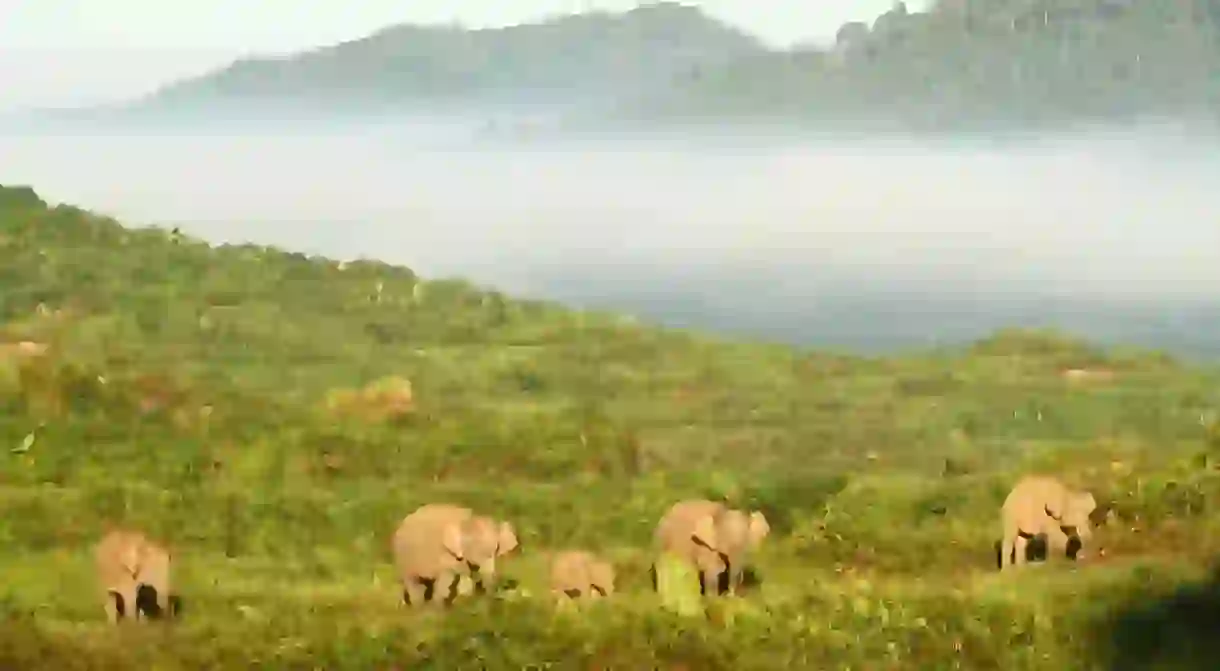Awesome Native Animals You Can See in Borneo

Indonesia, Malaysia and Brunei share the island of Borneo, one of the most biodiverse regions in the world. Inside the dense and often unexplored rainforests live elephants, deer, tigers, primates and several other types of plants, insects and birds. Discover the awesome animals in Borneo and where to see them below.
Planning a trip to Borneo and want all the details taken care of? Book yourself onto Culture Trip’s 10-day Bornean adventure, which includes a visit to an orangutan sanctuary, organic tea farm and a snorkelling trip in Kota Kinabalu.
Proboscis monkeys
The proboscis monkey, or nasalis larvatus, is probably the most unusual animal in Borneo. The reddish-brown primate has a long nose, which can reach up to 18cm (7in) in males. The elongated nose helps to attract mates and to amplify the sound of warning calls. Grey limbs and a distinctive pot belly are other defining characteristics. Living on a diet of mainly mangrove shoots and insects, the proboscis monkey, named after its nose, are strictly protected animals with estimates suggesting only 1,000 remain in the wild. Small populations live in Kota Belud and Beaufort near Kota Kinabalu and along the Kinabatangan River in Eastern Sabah.

Orangutans
Orangutan translates to man of the forest, referring to the resemblance of this primate to humans. The intelligent animals only live in Borneo and the Indonesian territory of Sumatera and are relatively solitary compared to other species. Sadly, with deforestation, logging and hunting, orangutan numbers are sharply declining.
Sun bears
When people hear the term bear, they automatically think of polars and grizzlies. But Borneo has a species called a sun bear. The bears, also called Malayan sun bears, live in the dense lowland forests of Southeast Asia. With a relatively small size, they often resemble a small dog; a nocturnal and shy species, they are rare to see in the wild. Take a trip to the Danum Valley Conservation Area in Sabah for your best chance of seeing these cute creatures living in their natural habitat.
Pangolins
The critically endangered Sunda pangolin is sometimes said to resemble an artichoke with legs. The critter is the only mammal covered in scales and has a tongue stretching longer than its body. Though we know they feast on a diet of ants and insects, there’s still much we have to learn about these elusive, nocturnal animals. If you’re staying in Rasa Ria, Kota Kinabalu, you can join a pangolin night trek through the rainforest in search of the animal.

Sambar deer
The nocturnal sambar deer, or rusa, are among the biggest deer in Asia. Adult males can reach a length of more than 2m (7ft) and weigh more than 200kg (441lbs). Found across much of Southeast Asia, rusa are at home in the Bornean rainforests and tend to be some of the easiest animals in Borneo to spot.
Mouse deer
While not technically a deer (classified as a tragulidae), this nocturnal and solitary critter lives mostly in the rainforests of Borneo and Sumatera. Reaching a height of barely 30cm (12in), the mouse deer holds the title of the smallest hooved animal in the world. These shy animals possess a remarkable reproductive ability: females may conceive just two hours after birth and newly born fauns can stand after 30 minutes.

Borneo pygmy elephants
The smallest elephant in the world is among the cutest animals in Borneo. Living in northern and northeast Borneo, these tiny elephants with oversized ears and long tails are declining because of deforestation and hunting. Estimates suggest only 1,500 to 3,000 remain in the wild, making the friendly and adorable elephants in dire need of protection. Lucky tourists might catch a glimpse of the Borneo pygmies at Danum Valley Conservation Area or, believe it or not, swimming in the Kinabatangan River.
Clouded leopards
Clouded leopards are among the most elusive animals in Borneo. Preferring to live in the treetops throughout the rainforests of Asia, the leopard possesses an incredible ability to climb. The nocturnal creatures hunt smaller mammals including deer, pigs and even monkeys. Given their nature, seeing a clouded leopard in the wild is rare.

Hornbills
The elegant and gracious hornbills, known for their unusual double-storied bill, live throughout the tropics in Asia and Africa. But Sarawak holds a special place for those wanting to catch a glimpse of the giant birds. Housing eight out of the 54 species, Sarawak deserves the state nickname, the Land of the Hornbills. The most common is the black-bodied and white-tailed rhinoceros hornbill with a white and orange beak, which features on the state emblem.

Sumatran rhinos
Sadly, the Sumatran Rhino is on the verge of extinction. With the title as the smallest in the world and having a body covered in long hair, the only two-horned rhino in Asia has a reputation for being so elusive that even rangers rarely see one. It’s unknown how many remain, but estimates suggest less than 100 live in northern Sumatra and the heart of Borneo.
Bornean slow loris
The Bornean slow loris, or nycticebus borneanus, is classified as a primate but looks more like a tiny lemur. Living a nocturnal existence, this animal can be quite challenging to spot in its natural habitat. Relatively large populations live in central Borneo, and new species of slow loris are still being discovered today.














